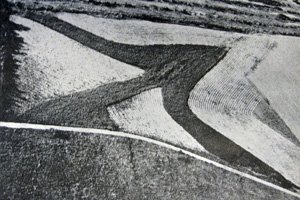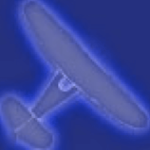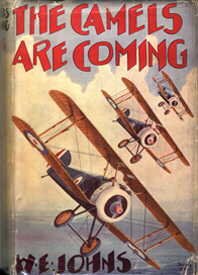Via Museum of Hoaxes, the Nazi air marker hoax — though it seems to me that it was not a hoax in the sense of a deliberate attempt to deceive, but rather an honest misinterpretation. And taking into account the role of the press in the story’s rise and fall, it looks a lot like what I’d call a defence panic.

What happened was that in August 1942 the US Army issued a press release claiming that its airmen had discovered strange patterns in fields across the eastern United States, which appeared to point in the direction of important nearby military and industrial sites. This was offered as evidence that enemy agents were active in the US, laying down signals for German bombers. Nearly two thousand newspapers (including Time) across the country published the story, and editorialised about the enemy within.
Of course, the patterns weren’t Nazi air markers; they were the result of perfectly ordinary rural activities, which had been appearing for years without anybody paying any attention to them. For example, the one shown above was created in 1938 under the supervision of the Department of Agriculture. It’s just the way the field had been ploughed. It was only now, when the country was at war and people were worried about its security, that such patterns were interpreted as signs of danger. It took a sceptical Washington Star and a sheepish confession from the War Department to lay fears of a fifth column to rest.
One aspect I found interesting is that the same story had circulated in a few newspapers in June, but for some reason didn’t take off as it did a couple of months later. The major difference seems to have been the addition of photos of the supposed markers. Maybe they were the evidence needed to make the stories plausible. Maybe they just made the stories more striking and so more appealing to editors. Or it could just be that they were desperate for news in the slow summer months. But it could also be that there was some domestic reason why security was more of a concern in August.
There are a number of obvious parallels. This was not the first time that Americans had imagined aerial threats to their nation: in the First World War — even before their country was in it — there were reports of aircraft flying across the border from Canada at night, perhaps bringing spies and saboteurs. That there were plenty of less dangerous ways for German agents to enter the country dampened the rumours in 1916 about as much as the improbability of New Jersey or Virginia being bombed did in 1942.
The idea of covert signals to enemy bombers can be found in the British press in both world wars. For example, in September 1940, Emil and Alma Wirth, an elderly Swiss-German immigrant and his British-born wife, were arrested on suspicion of ‘making signals “intended to be received by an aircraft in flight”‘ from their Kensington flat. A neighbour, who presumably reported them to the police, said that during an air raid on the night of 24 August he’d seen ‘flashes from the window of the accused whenever an aeroplane appeared to be overhead’. A porter also gave evidence against the couple. It’s not clear from the press accounts, but as the Wirths first appeared in court on 8 September, they may have been arrested in response to the first day of the Blitz, the day before. At any rate the magistrate dismissed the charges, so evidently he wasn’t particularly impressed by the evidence against them. It seems that they weren’t even fined for violating the black-out, which perhaps suggests that there may have some personal reason for the accusations — and being an ersatz German, Emil was an easy target, of course.1 Sounds like a bit of a witch-hunt, but as the magistrate’s response — and the Washington Star‘s scepticism — shows, just because it was war-time doesn’t mean that paranoia was automatically given free reign.
Update: something very similar happened in Britain too.
![]() This work is licensed under a Creative Commons Attribution-NonCommercial-NoDerivatives 4.0 International License.
Permissions beyond the scope of this license may be available at http://airminded.org/copyright/.
This work is licensed under a Creative Commons Attribution-NonCommercial-NoDerivatives 4.0 International License.
Permissions beyond the scope of this license may be available at http://airminded.org/copyright/.
- Manchester Guardian, 9 September 1940, p. 11; The Times, 9 September 1940, p. 9; 13 September 1940, p. 2. [↩]



Not quite on topic, but have you seen this?
http://news.bbc.co.uk/1/hi/uk/7404052.stm
(apologies, not sure if people outside Britain can see the splendid video clip! so if not, I’m sorry for wasting your time)
Thanks, it worked fine here in Aus. Splendid.
Airey Neave’s book about the fall of Calais makes much of French “collaborators” and “fifth columnists” working with Germans to take the town.
It shows that even highly intelligent and (presumably) level headed individuals believed there was a huge and active sabotage effort directed against them – as far as I can remember, no historian takes this view seriously today…
I suspect you’re right about that. There’s an excellent paper on this subject: Glyn Prysor, “The ‘Fifth Column’ and the British experience of retreat, 1940”, War in History 12 (2005), 418-47. It does draw on post-war accounts of Calais (not Neave’s though): some soldiers remained convinced that there were fifth columnists there, others were a lot more sceptical.
Pingback: Airminded · The Germans are coming! — II